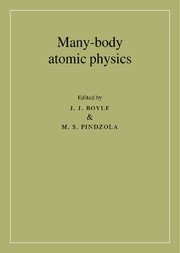Book contents
- Front Matter
- Contents
- Foreword
- Contributors
- Preface
- Acknowledgements
- Part 1 ATOMIC STRUCTURE
- Part 2 PHOTOIONIZATION OF ATOMS
- 4 Many-body effects in single photoionization processes
- 5 Photoionization dominated by double excitation in two-electron and divalent atoms
- 6 Direct double photoionization in atoms
- 7 Photoelectron angular distributions
- Part 3 ATOMIC SCATTERING: A. General Considerations
- Part 3 ATOMIC SCATTERING: B. Low-order applications
- Part 3 ATOMIC SCATTERING: C. All-order applications
- Appendix: Units and notation
- References
- Index
7 - Photoelectron angular distributions
Published online by Cambridge University Press: 22 September 2009
- Front Matter
- Contents
- Foreword
- Contributors
- Preface
- Acknowledgements
- Part 1 ATOMIC STRUCTURE
- Part 2 PHOTOIONIZATION OF ATOMS
- 4 Many-body effects in single photoionization processes
- 5 Photoionization dominated by double excitation in two-electron and divalent atoms
- 6 Direct double photoionization in atoms
- 7 Photoelectron angular distributions
- Part 3 ATOMIC SCATTERING: A. General Considerations
- Part 3 ATOMIC SCATTERING: B. Low-order applications
- Part 3 ATOMIC SCATTERING: C. All-order applications
- Appendix: Units and notation
- References
- Index
Summary
Introduction
Collision experiments provide a considerable portion of our information on the interactions between particles, as well as on the internal structure of the particles themselves, in all of the subfields of modern physics. When the interactions between particles are large, information is obtained primarily on the collision process itself; when the interactions are small, the collision probes principally the structure of the interacting particles. Since the coupling between the photon field and the electron is small, photoionization is an example of the latter type of process. Furthermore, since the photon is not thought to possess any internal structure, photoionization is clearly a probe of the target atom.
In photoionization, as in any collision process, measurements of total cross sections provide information on the absolute squares of matrix elements. Differential cross sections, angular distributions, provide information on the matrix elements themselves, including their relative phases. Thus, angular distribution studies allow us to peel back one more layer of the “onion.” Furthermore, in many cases, photoelectron angular distributions are much more sensitive to many-body effects, i.e., the effects of correlation, than are total cross sections; in fact, there are many instances in which many-body effects dominate the structure of the differential cross section.
The purpose of this chapter, then, is to provide a theoretical framework for the understanding of the physics of atomic photoelectron angular distributions. Within this framework, the separation between angular momentum geometrical factors and dynamical, wave-function-dependent, factors in the determination of the angular distribution will be highlighted.
- Type
- Chapter
- Information
- Many-Body Atomic Physics , pp. 167 - 182Publisher: Cambridge University PressPrint publication year: 1998
- 4
- Cited by

